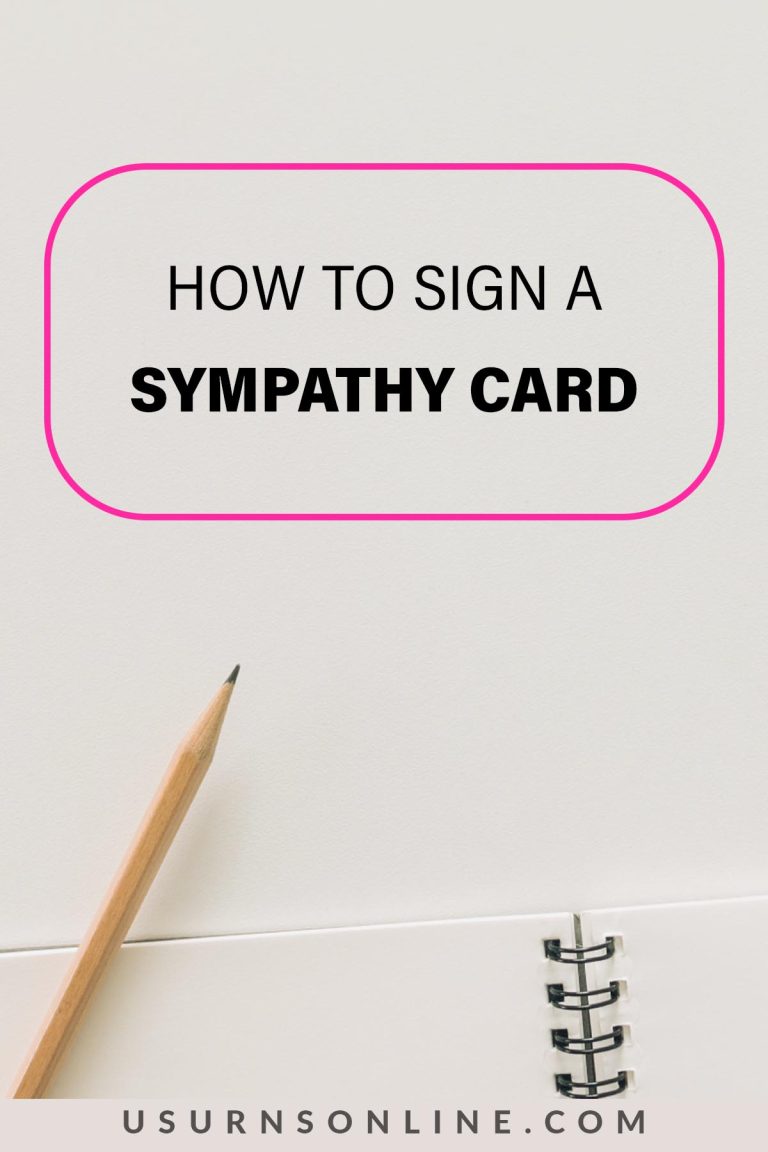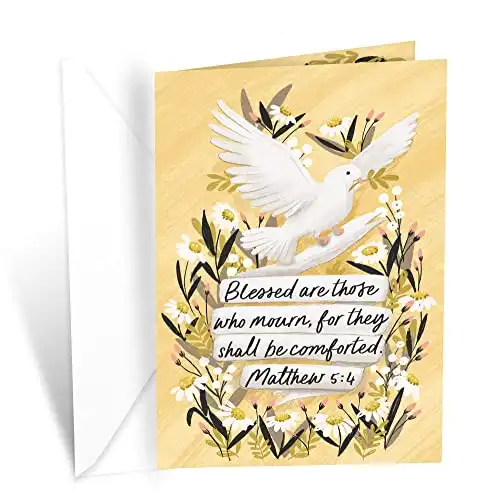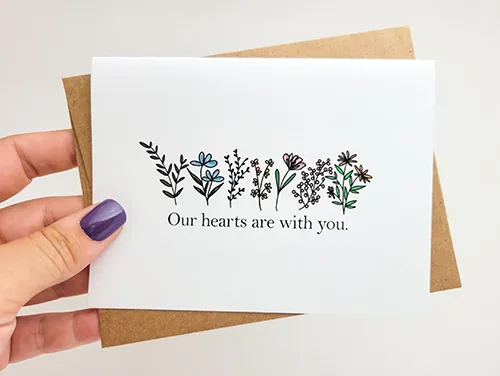It can be hard to figure out how to properly sign a sympathy card. No matter who the card is for, whether a close family member, a best friend, an acquaintance, or a distant relative, it’s often difficult to figure out the right things to say to someone who is grieving, and to properly express sympathy.
That said, signing a sympathy letter shouldn’t feel like rocket science either, so today we’ll be sharing with you:
- Tips for writing your sympathy message, from the beginning
- Tips for ending/signing your sympathy card appropriately
- Some examples to help you accomplish both of those tasks
Let’s get started.
Our website is supported by our users. We sometimes earn a commission when you click through the affiliate links on our website. See our privacy policy & disclosures for more information.
Sympathy Card Messages
Let’s take a look at what goes into writing and signing a sympathy card, from start to finish.
It’s important to remember to be yourself as you write. You should be sincere, of course, but there is no need for you to overdo it.
What I mean is this: don’t think too much about your sympathy message before you even start it.
Yes, your loved ones are grieving, but they are still, well, them. There’s a delicate balance there.
So many people don’t know how to approach a grieving person, as if they have changed in some drastic way now that their loved one has died. Your loved one has no doubt experienced this, so being the same you will bring them more comfort than you know.
Still, sometimes it’s helpful to have some sort of idea about what to write.
Urns Made in the USA
Step 1. Begin with Some Words of Comfort
Grab some paper and a pen (or your laptop or cell phone, whatever medium you prefer). Jot down some notes and get everything you want to say organized before you write it in ink into the card. Or you’ll be headed right back to the store to pick up another one!
You may even want to write a rough draft of sorts, before penning the final message into the card.
In any case, you’ve got to get the intro down first. Here are some examples of short intros, and a little bit longer ones, to help get you started:
You can keep it short and sweet…
- “Dear ________, I am so sorry to hear about the loss of _________. They were a wonderful person inside and out; we will all miss him/her sorely.”
- “Hi _________. Please accept my sincere condolences on the loss of ________. I know that there is nothing I can say right now that would bring you the same comfort of having them back again, but please accept my sincere condolences.”
- “__________, what can I say? Except that I am so, so sorry to hear about __________’s passing. He/she is no longer suffering, even if that is the one thing we can be thankful for right now. I am praying for you during this hard time.”
- “Sweet _______, may the Lord bring you comfort as you begin to process your great loss. There is nothing like the loss of a _________, but that said, a Bible verse that always helps me during periods of deep mourning is ____________.”
Related: Comforting Bible Verses for Grief
…Or make it as long and heartfelt as you’d like.
- “____________, it’s been way too long. I can’t believe that it took something like this to prompt me to reach out to you. I am so, so sorry about ___________. If there is anything at all that I can do for you and your family, please let me know. Keep in mind that I am just a phone call away if you need anything…in fact, I’m sure there is something I could do for you right now. Name it and I’ll be there. Here is my number/email address:_____________.”
- “I can’t believe that I’m sitting here writing this to you. How could it possibly be that _______ is gone? He/she was so full of life, that it just seemed impossible. I can’t even begin to imagine what you must be going through right now, and I’ve been wracking my brain trying to make sense of it all. But deep down I know that we just have to trust in God and lean not on our own understanding.
- “Hi, _________. I just heard about __________. I’m in utter shock and really don’t know where to begin. I am so very sorry that you are having to deal with this right now. _________ was such an amazing person; I have so many memories and stories to share with you the next time I see you. Please just let me know when you would like to get together to do that. In the meantime, I would like to share just one special memory I have of ________.”
For more inspiration on figuring out what to write in your sympathy card, see our guide on sympathy card writing examples.
And speaking of memories….
Step 2. Share a Memory or Story You Have of the Deceased
That brings us to our next tip: add in a special memory or story of the deceased (it can be funny, that’s totally okay) to help brighten your loved one’s day.
This is the kind of content that turns greeting cards (especially sympathy cards) into keepsakes:
- “We have such fond memories of ________. I remember this one time, me and _____________ went on this trip together to _________. It was just the two of us, and it was during this trip that I first got a real sense of his/her sense of humor! [Insert joke/funny story].
- “_________ was the most kind-hearted person I know. He/she once [insert a time when the deceased did something thoughtful for someone else/showed their generous side.]
- “Not many people knew this about ________, but he/she….”
- “Did you know that ________ knew how to [insert unique talent]? I hope they wouldn’t mind me telling you about it now!”
- “_________ always spoke so highly of you. He/she once had this to say about you:_____________. Obviously, they had unconditional love for you. Please know, they are in a better place.”
Step 3. Add Specific Sympathy Quotes and Condolence Messages
When writing your condolence letter, sprinkling in a quote or two can help to get the creative juices flowing. Here are some examples of specific quotes you can consider adding for an extra personal touch:
- “The Lord is close to the brokenhearted, and saves those who are crushed in spirit.” Psalm 34:18
- “Where there is deep grief, there was great love.” Unknown
- “Grief is just love with nowhere to go.” Jamie Anderson
- “The song is ended, but the melody lingers on.” Irving Berlin
- “There are no goodbyes for us. Wherever you are, you will always be in my heart.” Gandhi
- “In the end, it’s not the years in your life that count. It’s the life in your years.” Abraham Lincoln
- “How can the dead be truly dead when they still live in the souls of those who are left behind?” Carson McCullers
- “If there ever comes a day when we can’t be together, keep me in your heart, I’ll stay there forever.” A.A. Milne
Step 4. How to Sign a Condolence Card
Now let’s answer the question as to why you landed on this page, to begin with: How to end a sympathy card?
Once you’ve got your intro and any memories or stories you’d like to share with the grieving family written out, it’s time to bring your message to a close.
When ending a message of sympathy, it’s best to still keep it on a personal note, but short and simple; no need to go on and on about the loved one who has passed, or share too many details about them when they were alive.
Closing Lines
Here are some brief examples to help you close with a message of support in your sympathy card painlessly and seamlessly:
- Again, please accept my deepest sympathy.
- In loving memory of [decedent’s name].
- You and the family will be in our thoughts during this difficult time.
- In Memoriam.
- I will be praying for you.
- We’re sending love and prayers your way.
- You have our heartfelt condolences.
- We’re thinking of you with much love.
Sign-Offs
Here are some words and phrases to precede your signature:
- With sympathy,
- Our condolences,
- Yours,
- Sincerely,
- Most affectionately,
- Affectionately yours,
- Thinking of you,
- Prayerfully,
- Love,
- With much love,
- Many hugs,
- Sincerely,
Then simply sign your name. For sympathy closings addressed to close friends and relatives, your first name could be enough. But typically you will want to sign your full name.
Best Sympathy Cards to Write a Heartfelt Message
Looking for a sincere and heartfelt sympathy card, that is also eye-catching and original? We’ve done the hard work for you and uncovered these gems.
Whether you need a sympathy card for the loss of a father or loss of a mother, this beautiful custom starry night design fits the bill.
Featuring a starry backdrop and a comforting quote, this card is specifically designed to soothe a difficult chapter in life, such as the loss of a parent.
Sometimes, a simple card with a simple font is all you need to get the meaning across in a big way.
If you would like to send a loved one a gentle condolence card with an appropriate message for the unimaginable loss of a child, this gentle, minimalistic card may be just what you’re looking for.
It is also customizable to fit your needs.
The loss of a pet calls for a heartfelt sympathy note. If you are looking for a beautiful, meaningful sympathy card for loss of a pet, look no further.
A sense of peace will wash over your loved one as they view this gorgeous card – complete with a watercolor illustration of the Rainbow Bridge – and hopefully, their grieving process will be gently aided.
This card also comes in a sweet cat lover’s edition.
A person’s religious beliefs play a major role in how they will process their experience with grief. So when shopping for sympathy cards, it is appropriate that you find one that includes a nod to their spirituality, as both a show of respect as well as a gesture of sympathy.
This lovely card includes a familiar religious condolence message and is designed to bring your loved one the comfort they need right now.
Sometimes you don’t necessarily need to give a specific sympathy card. Sometimes, you just need a sweet card with an understanding, heartfelt message.
This simple, floral garden sympathy card is a good example of a simple yet comforting sympathy card that will still go miles in showing just how much you care.
Why Send a Sympathy Card?
Sympathy cards are a type of greeting card that you can purchase or make yourself to send to someone. It’s an expression of your sympathy and a wonderful way to remind them that you are thinking about them in their time of loss.
When someone you know has lost a loved one, sending a sympathy card is not only customary, it’s also just a nice thing to do.
You can also send an e-card if you prefer not to send a paper one. Or you can send an email or text message much the same.
When to Send a Sympathy Card
Send it Right Away
Generally, you mail or hand-deliver a sympathy card to the person it’s intended for not long after you hear about their loved one’s passing.
Other Meaningful Dates
It may also be appropriate to send a card or condolence message on a subsequent date, such as a death anniversary or a special holiday. These are times that can be particularly difficult, so a card will be a very welcome show of support.
For more inspiration, we put together a list of memorial messages for death anniversaries.
When You Hear About It
If you hear about a passing after the fact, it’s perfectly okay to go ahead and send your condolences then. The family will appreciate you thinking of them and taking the time to let them know now.
Feel free to be honest about the fact that you just found out about the death of their loved one: “I just heard about ________. I am so, so sorry.”
Have you ever received a sympathy card that just blew you away? Or perhaps you have a favorite saying or poem that you have included in a message of condolence you have given. Feel free to share in a comment below!
Read next: Condolence Messages to Express Your Love & Support










